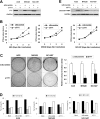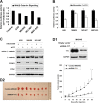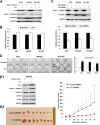Yin Yang 1 contributes to gastric carcinogenesis and its nuclear expression correlates with shorter survival in patients with early stage gastric adenocarcinoma
- PMID: 24674326
- PMCID: PMC3986816
- DOI: 10.1186/1479-5876-12-80
Yin Yang 1 contributes to gastric carcinogenesis and its nuclear expression correlates with shorter survival in patients with early stage gastric adenocarcinoma
Abstract
Background: Yin Yang 1 (YY1) is a transcription factor that regulates diverse biological processes and increasing recognized to have important roles in carcinogenesis. The function and clinical significance of YY1 in gastric adenocarcinoma (GAC) have not been elucidated.
Methods: In this study, the functional role of YY1 in gastric cancer was investigated by MTT proliferation assays, monolayer colony formation, cell cycle analysis, signaling pathway analysis, Western blot analysis and in vivo study through YY1 knockdown or overexpression. Immunohistochemical study with YY1 antibody was performed on tissue microarray consisting of 247 clinical GAC samples. The clinical correlation and prognosis significance were evaluated.
Results: YY1 expression was up-regulated in gastric cancer cell lines and primary gastric cancers. Knocking down YY1 by siYY1 inhibited cell growth, inducing G1 phase accumulation and apoptosis. Ectopic YY1 expression enhanced cell proliferation in vitro and in vivo. Knocking down YY1 in gastric cancer cells suppressed proliferation by inhibiting Wnt/β-catenin pathway, whereas its overexpression exerted oncogenic property by activating Wnt/β-catenin pathway. In primary GAC samples, YY1 nuclear expression correlated with shorter survival and predicted poor prognosis in early stage GACs.
Conclusion: Our data demonstrated that YY1 contributes to gastric carcinogenesis in gastric cancer. In early stage GACs YY1 might serve as a poor prognostic marker and possibly as a potential therapeutic target.
Figures





References
Publication types
MeSH terms
Substances
LinkOut - more resources
Full Text Sources
Other Literature Sources
Medical
Molecular Biology Databases
Research Materials

